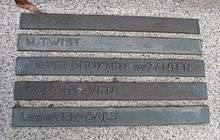Jacob Veldhuyzen van Zanten
| Jacob Veldhuyzen van Zanten | |
|---|---|
 An advertisement in the KLM magazine Holland Herald featuring him. The magazines with this ad inside were on board KLM Flight 4805. | |
| Born |
5 February 1927 Lisse, Netherlands |
| Died |
27 March 1977 (aged 50) San Cristóbal de La Laguna, Spain |
| Nationality | Dutch |
| Alma mater | KLM |
| Occupation | Pilot |
| Years active |
1950-1977 Spouse: Henriëtte Veldhuyzen van Zanten-Segers (b. 1926) Children: Ron (b. 1951) and Mariëtte (b. 1953) |
| Known for | KLM's chief instructor, Tenerife Airport Disaster |
Jacob Louis Veldhuyzen van Zanten (5 February 1927 – 27 March 1977) was a Dutch aircraft captain and flight instructor. He was the captain of the KLM Royal Dutch Airlines Boeing 747 which was involved in the Tenerife airport disaster, the deadliest accident in aviation history.
Biography
Born in Lisse, Netherlands, Veldhuyzen van Zanten obtained his private pilot's licence on 21 June 1947, and his commercial pilot's licence on 18 April 1950. That year, he began working for KLM Royal Dutch Airlines as a flight director, and in 1951, he commenced duty as a first officer on the Douglas DC-3.[1] He then obtained his Flight Radio Telephone Operator's Licence on 22 September 1952, Airline Transport Pilot's Licence on 19 October 1956, and Flight Navigator's Licence on 6 August 1963.
On 23 January 1971, Veldhuyzen van Zanten was type-rated on the Boeing 747. That same year, he, along with two of his colleagues, went to Seattle to take delivery of KLM’s first 747, the Mississippi (registered PH-BUA).[1] At the time of the disaster, he had 11,700 flight hours (1,545 of which were on the Boeing 747).[2] In addition to his duties as a regular airline pilot, he had been promoted to chief flight instructor for the Boeing 747.[3] At the time of his death, he was in charge of training all of KLM's pilots on this type of aircraft and the head of KLM's flight training department.[4]
Jan Bartelski, a KLM captain until 1978 and later president of the International Federation of Air Line Pilots' Associations, was a contemporary of Van Zanten and knew him personally. In his book Disasters In The Air, he describes Van Zanten as:
a serious and introverted individual but with an open-hearted and friendly disposition. He was a studious type and regarded as the company’s pilot expert on the Boeing 747 systems.
And adds that:
He believed in partnership, to the extent that he insisted on his first officers addressing him during flight as «Jaap» and not «Captain van Zanten».[3]
Shortly before the disaster, Veldhuyzen van Zanten was photographed for KLM's advertising campaign.[5] While this has been attributed to his high position within KLM, Jan Bartelski, for instance, argues that Veldhuyzen van Zanten was photographed simply because he was the only captain available (due to his responsibilities as a flight instructor) to KLM Public Relations, as others were away flying.[3]
When the news of the disaster broke, the KLM executives looked for Veldhuyzen van Zanten to lead their investigation, only to realize that he had been involved in the accident.[6]
Veldhuyzen van Zanten lived in Sassenheim, Netherlands, and was survived by his wife and two children.[7]
Tenerife disaster
The Tenerife airport disaster on 27 March 1977 was the collision of two Boeing 747 passenger aircraft on the runway of Los Rodeos Airport (now known as Tenerife North Airport) in Tenerife, Spain; killing 583 people, the crash is the deadliest accident in aviation history. All 248 aboard KLM flight 4805 were killed, as were 335 people on Pan Am flight 1736.
In heavy fog on the airport's only runway, Veldhuyzen van Zanten took off without clearance and crashed into the top of the Pan Am aircraft, which was backtaxiing in the opposite direction under the direction of Air Traffic Control; the KLM's flight crew had been aware of Pan Am backtaxiing behind them on the same runway. The dense fog prevented visual confirmation; the KLM captain thought that Pan Am had cleared the runway, and started to take off without further clearance to do so. Veldhuyzen van Zanten's actions were the result of a number of other factors, including communication difficulties with Air Traffic Control (accents, and non-standard phraseology); he wrongly believed he had been given take off clearance when he received a departure clearance, and the Control Tower assumed that the KLM 747 remained stationary on the runway as instructed.[8]
Aircraft type ratings
Veldhuyzen van Zanten was rated for the following aircraft:[2]
- Douglas DC-3 from 28 September 1951 to 20 June 1962.
- Convair CV240/340 from 23 August 1952 to 20 June 1962.
- Lockheed Constellation from 1 October 1952 to 20 June 1962.
- Douglas DC-6 from 12 February 1957 to 20 June 1962.
- Douglas DC-7C from 6 June 1957 to 20 June 1962.
- Vickers Viscount 803 from 11 June 1959 to 21 July 1967.
- Douglas DC-9 from 16 March 1967 to 9 June 1971.
- Boeing 747 from 23 January 1971 to 27 March 1977.

References
- 1 2 "Wie was Veldhuyzen van Zanten?" (in Dutch). Project Tenerife. Retrieved 2010-01-23.
- 1 2 "Part One of the Spanish Report" (PDF). Project Tenerife. Retrieved 2010-01-23.
- 1 2 3 Bartelski, Jan (2001). Disasters in the air: mysterious air disasters explained. Airlife. pp. ?. ISBN 978-1-84037-204-5.
- ↑ Meisler, Stanley (1977-03-30). "'He Is Going to Kill Us,' Pan Am Pilot Exclaimed". Los Angeles Times. p. B1.
- ↑ KLM advert
- ↑ Smith, Patrick: "A look back at the catastrophic chain of events that caused history's deadliest plane crash 30 years ago." Salon. April 6, 2007. Retrieved on December 21, 2012. 1.
- ↑ Sterk, N. (1997-03-22). "Een handbreed gesteld". Reformatorisch Dagblad (in Dutch). p. B1. Retrieved 2013-10-26.
- ↑ Job, Macarthur (1994). Air Disaster Volume 1. Fyshwick, Australia: Aerospace Publications. p. 174. ISBN 1875671110.